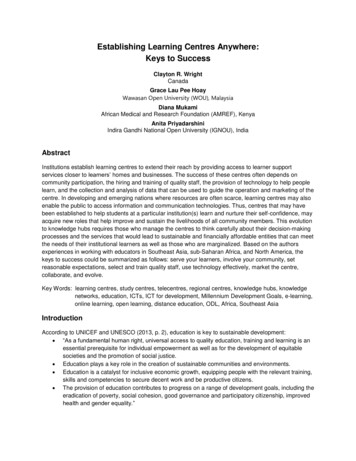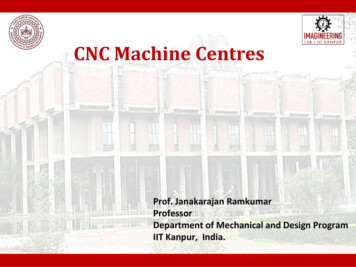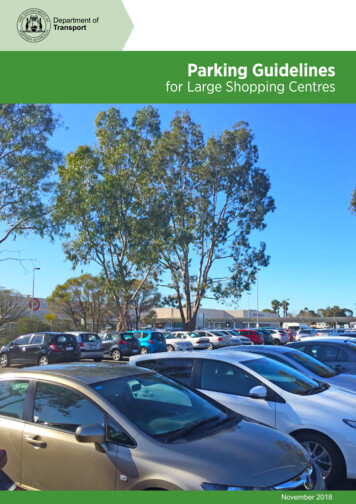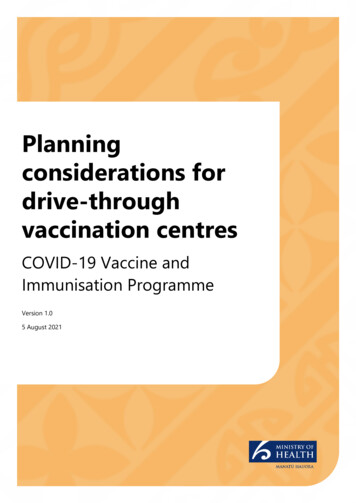
Transcription
Establishing Learning Centres Anywhere:Keys to SuccessClayton R. WrightCanadaGrace Lau Pee HoayWawasan Open University (WOU), MalaysiaDiana MukamiAfrican Medical and Research Foundation (AMREF), KenyaAnita PriyadarshiniIndira Gandhi National Open University (IGNOU), IndiaAbstractInstitutions establish learning centres to extend their reach by providing access to learner supportservices closer to learners’ homes and businesses. The success of these centres often depends oncommunity participation, the hiring and training of quality staff, the provision of technology to help peoplelearn, and the collection and analysis of data that can be used to guide the operation and marketing of thecentre. In developing and emerging nations where resources are often scarce, learning centres may alsoenable the public to access information and communication technologies. Thus, centres that may havebeen established to help students at a particular institution(s) learn and nurture their self-confidence, mayacquire new roles that help improve and sustain the livelihoods of all community members. This evolutionto knowledge hubs requires those who manage the centres to think carefully about their decision-makingprocesses and the services that would lead to sustainable and financially affordable entities that can meetthe needs of their institutional learners as well as those who are marginalized. Based on the authorsexperiences in working with educators in Southeast Asia, sub-Saharan Africa, and North America, thekeys to success could be summarized as follows: serve your learners, involve your community, setreasonable expectations, select and train quality staff, use technology effectively, market the centre,collaborate, and evolve.Key Words: learning centres, study centres, telecentres, regional centres, knowledge hubs, knowledgenetworks, education, ICTs, ICT for development, Millennium Development Goals, e-learning,online learning, open learning, distance education, ODL, Africa, Southeast AsiaIntroductionAccording to UNICEF and UNESCO (2013, p. 2), education is key to sustainable development: “As a fundamental human right, universal access to quality education, training and learning is anessential prerequisite for individual empowerment as well as for the development of equitablesocieties and the promotion of social justice. Education plays a key role in the creation of sustainable communities and environments. Education is a catalyst for inclusive economic growth, equipping people with the relevant training,skills and competencies to secure decent work and be productive citizens. The provision of education contributes to progress on a range of development goals, including theeradication of poverty, social cohesion, good governance and participatory citizenship, improvedhealth and gender equality.”
Thus, it is important for all countries to increase access to quality educational opportunities. Increasedaccess not only means more physical access, but also increased affordability and eligibility. In developingand emerging countries, the need to increase educational access is great yet the resources are few. Inthese countries, governments are often tasked with the responsibility for providing access to education atthe same time as they are faced with rising populations and scarce resources. Because it is not practicalfor governments or institutions to build a campus comprising classrooms, laboratories, and residencies inevery district, institutions may establish learning or study centres that expand their reach by offering faceto-face contact in local communities. Over time, some learning centres will evolve to become knowledgehubs that incorporate the functions of learning centres as well as the functions of public information andcommunication technology (ICT) access points or telecentres. When such centres are linked andmanaged by a single entity, a knowledge network is formed.The terms used in this document are based on the brief explanations below. Learning centre / study centre / learner support centre – established by an institution or group ofinstitutions to extend its reach by providing access to learner support closer to learners’ homesand businesses. Its primary function is to attract, support, and retain learners. Learning centresare often established in existing educational institutions and share physical and human resourceswith a distance learning institution.Regional centre – a sub-office of the parent institution. Usually, it is a purpose-built centre thatcarries out many of the administrative and delivery functions of the institution, but on a smallerscale. In some instances, the regional centre is responsible for several learning centres that arelocated in rental or rent-free space provided in institutions and/or communities within a region.Community learning centre – a local educational entity that lies outside the formal educationsystem. It is usually established and managed by local residents to provide lifelong learningopportunities that focus on literacy and basic education. The centres may also organize activitiesthat promote cultural programs, computer training, empowerment of women, health, hygiene,income generation, and skill development (UNESCO, 2008).Telecentres / Internet centres / cyber cafes – public ICT access points (Royer, 2013; UnitedNations Economic Commission for Africa, 2011)Knowledge hubs – provide public access to technology, and gather and distribute informationabout and for the community. They are intermediaries between telecentres and knowledgenetworks (Ariyabandu, 2009). Learning centres may become knowledge hubs by incorporatingthe functions of telecentres, thereby affording members of the community access to technologyand information tailored to suit community needs.Knowledge networks – group of knowledge hubs that share information and expertise, and mayadvocate to government and private interests (Ariyabandu, 2009)Rationale for the Learning CentreSupporting learners as they strive for successLearning centres are often established to provide easy access to an institution or group of institutions andto assist learners who may experience difficulty completing assignments and courses because they lackaccess to educational resources, ICTs, tutoring, and guidance. The presence of learning centres in acommunity may also financially benefit students as they will not need to travel to the primary institution asoften and thus, avoid the loss of income they would incur if they had to frequently travel to a major centre.From a political perspective, all citizens need access to educational opportunities, not just those inEstablishing Learning Centres Anywhere: Keys to Success - Wright, Lau Pee Hoay, Mukami & Priyadarshini2
selected urban areas. Thus, learning centres may be established to address national as well as localcommunity needs.Learning centres should be designed to meet the needs of learners and to support their efforts as theystrive for educational success. Accordingly, learning centres may enable learners to: obtain information about educational offerings from one or more institutions and/or attendinductions/orientation programs offered by institutions; receive courses from one institution or group of institutions; procure information and educational resources; access ICTs such as computers, the Internet, and videoconferencing facilities; listen to radio programs or watch video recordings or television programs; access library services; learn how to improve their study, writing, and reading skills; gain insight into coping strategies that may help them address stress and feelings of isolation andoverload; use resources that help them overcome disabilities that affect their capacity to learn; meet with a tutor or mentor; participate in group tutorials; gather for seminars and/or discussions; drop-off and pick-up assignments; obtain feedback on assignments; participate in mock examinations; take supervised tests or examinations; study away from home; obtain counselling; learn about educational and employment opportunities related to their course of study; and immediately apply the knowledge and skills they acquire. For example, when the learning centrefor health workers is located within a health facility, students can immediately practice and applytheir new skills.Thus, a variety of activities can be conducted at learning centres, and space must be provided forasynchronous and synchronous learning activities, social interaction, and administration. Socialization isan important activity that can be facilitated at learning centres; students share their knowledge andexperiences as they complete their educational journey as well as provide each other with moral support.The actual functions performed at learning centres will vary depending on the available resources and thefeedback provided by students and the community. Some may offer basic services while others offermore sophisticated assistance. A few examples of the different forms of learning centres and the servicesthey provide are outlined below. The Malawi College of Distance Education (MCDE) established study centres, throughoutMalawi, that provide academic and administrative support. At these centres, students are able toregister for courses, pay course and tuition fees, meet with a mentor, seek counselling, submittutor-marked assignments, take supervised examinations, and obtain educational resources,primarily print material. These centres may be established at secondary schools and operate afterthe regular students have gone home and on the weekends.The Wawasan Open University (WOU), Malaysia, enables individuals, regardless of theirprevious educational, ethnic, or socio-economic background, to pursue one of 40 self-pacedEstablishing Learning Centres Anywhere: Keys to Success - Wright, Lau Pee Hoay, Mukami & Priyadarshini3
programs of study while they continue to work at their jobs. WOU established six regional centresthat recruit students, provide counselling, and offer access to resources such as a virtual libraryand a physical library as well as ICT support. The regional centres also serve as a studentinformation hub where students can make inquiries as well as file complaints.The Botswana College of Distance and Open Learning (BOCODOL) provides a variety ofcertificate, diploma, and degree programs as well as short courses to 8,382 students. Theinstitution has five regional centres plus a network of 79 community study centres that offer all theservices itemized above as well as HIV/AIDS support, telephone tutoring, and support strategiesfor learners in special circumstances, such as prison in-mates. The primary responsibilities of theregional centres are to liaise with the local communities, schools, and other institutions, to marketBOCODOL programs, and to provide management information to headquarters.The Open University of Tanzania (OUT) offers degree programs in education, law, businessmanagement, arts and social sciences, and pure sciences. Students primarily receive instructionvia print materials, e-learning (via Moodle), compact discs, videocassettes, audiocassettes, andface-to-face tutorials. Students receive academic and administrative support from 30 regionalcentres, 10 coordination centres, and 69 study centres. Nineteen centres have computerlaboratories and 12 of these centres provide computer training to the community. By December2013, all regional centres will provide wireless Internet access. Regional and coordination centreshave mini-libraries. Centres are located in rented premises and facilities built specifically for OUT.The African Medical and Research Foundation (AMREF) is an international Africanorganization that aims to strengthen the capacity and capability of health and health-relatedprofessionals and institutions. Initiatives include the use of digital learning in the training of healthworkers in sub-Saharan Africa. In Kenya, AMREF supports more than 100 learning centreshoused within health training institutions and health facilities. These learning centres werecreated to help nurses who were seeking to upgrade their nursing credentials to a diploma whilethey continued to provide health services at their places of work. These centres offer mentorship,clinical practice and assessment, and access to digital and print learning content.The African Virtual University (AVU), based in Kenya and Senegal, aims to be the leading panAfrican open and distance learning network. In order to increase access to tertiary education, theinstitution enhances the capacity of 37 universities across 26 sub-Saharan African countries toengage in distance and e-learning. The AVU is establishing 37 Open Distance and e-Learning(ODeL) Centres and is training academics in e-learning methodologies. At these centres, learnerscan access open educational resources in English, French, and Portuguese. Currently, the focusis on teacher education programs for mathematics and sciences, and applied computer science.The National Institute of Open Schooling (NIOS), India provided courses to 493,534 academicand 26,354 vocational students in 2011-12. These students could access 2,931 academic studycentres and 1,487 vocational centres. In addition, there are 27 NIOS study centres located inKuwait, Muscat, Nepal, Qatar, and the United Arab Emirates. At these centres, students canattend face-to-face classes, participate in practical hands-on laboratory/workshop activities, andaccess course materials and a library. Support services such as counselling, tutorial support, andexamination preparation are also provided.The Indira Gandhi National Open University (IGNOU), India, offers 477 educational programs.As of April 2013, 3,016,770 learners were enrolled at the institution (IGNOU, 2013). Theselearners accessed 67 regional centres, 3,380 learner support or learning centres, and 80overseas centres in 43 countries. Most of these centres use existing space in a multiplicity ofeducational institutions. At these centres, students can participate in various academic activitiesor obtain support in these areas: academic tutoring, counselling, assignment assessment,examination preparation, library, and media/ICTs.Establishing Learning Centres Anywhere: Keys to Success - Wright, Lau Pee Hoay, Mukami & Priyadarshini4
Unless criteria for gauging the operational success of the centre are established at the outset, it will bedifficult for institutions to know whether the centre is successful in providing the support its students need.Although tracking the number of students served is a primary consideration, it is also important tomeasure the type and quality of the support provided and to offer an indication of why some criteria havebeen not met. For example, learning centres in some African countries may have educational resources,but due to the prohibitive cost of purchasing proprietary course materials and the high cost oftransportation, few resources may be available and these resources may be out of date. Thus, few peoplewill use them. Or, learners may attend a learning centre that has computers and Internet access, butstudents may be unable to use or have limited use of the hardware and software, because these itemsare under the control of a school principal who is concerned about theft and equipment damage.Consequently, simply recording the presence of resources and equipment available at a learning centregives no indication of how often they are used or how the equipment is being managed. Similarly,recording the number of people who come to the learning centre does not give an indication of how thecentre is used and what future services may be viable.Community Ownership and GovernancePeople value something they have a stake in.If the primary purpose of a learning centre is to meet the needs of the learners within the community, thenperhaps the community should be involved with the establishment and operation of the centre so that thecommunity can assume some form of ownership for the centre’s challenges and successes. Members ofthe community may be able to identify the potential benefits, constraints, and opportunities afforded bythe initiative. Concurrently, they need to be informed of the benefits, constraints, and opportunities asseen from the centre’s perspective.As institutions and/or governments traditionally pay for learning centres, they often establish learningcentres without any local community input. This approach can lead to the establishment of learningcentres at sites that may limit the use of the centre. For example, sites may be donated and save thegovernment money, but the sites may be on the edge of town some distance from bus routes and thelocal market. Hence, students have to make an extra effort to reach them and thus these centres attractfew students. Female students, in particular, may not be pleased; the out-of-the-way location and lack ofstreet lighting means they may not visit these centres after work or after a day of shopping at the market.Perhaps involvement by the community could facilitate the selection of better locations for learningcentres as members of the community would note issues such as transportation, safety, and visibility.Communities can demonstrate commitment by: assisting with the selection of the centre’s location, preferably a site with high visibility that takesinto account learner safety and proximity to transportation links. donating a room or providing free rent, thereby freeing up funds for additional or betterequipment, higher bandwidth, increased staff hours, and so forth. providing equipment. For example, Kenyan health facilities are required to provide basic furniturefor the computers installed in learning centres and to fortify/secure the room in which theequipment will be held. promoting the centre by advocating its benefits to community members. raising funds for the centre. volunteering to tutor students or perform specific tasks at the centre. providing actionable feedback that will help the learning centre staff improve the quality andefficiency of the services provided.Establishing Learning Centres Anywhere: Keys to Success - Wright, Lau Pee Hoay, Mukami & Priyadarshini5
suggesting the operational hours of the centre that would best suit the members of thecommunity. For example, the WOU regional centres are open until 10 p.m. during the week aswell as on weekends to better serve their working-adult clients who are unable to access thecentre during regular working hours or until after they have fulfilled family-related commitments.participating in the governance of the centre by suggesting services to be offered and addressingthe challenges encountered by centre staff.Governance may require the establishment of a hierarchical management structure comprising a locallearning centre committee and a network committee. While the former committee could oversee theoperation of a particular learning centre, a network committee could oversee the operation of all learningcentres within a region or country. However, if committees must make all the decisions, decision-makingwill be inefficient. If committees are too large, decision-making is often delayed. Thus, one person may bedesignated as manager and be responsible for the day-to-day operational decisions so that decisions canbe made in a timely fashion. The decision-making structure must be simple and clear to everyone.Learning centre and network committees may include educational administrators and importantcommunity members such as the elder/mayor, key businesspersons, teachers/instructors, and membersof the local community/parish assembly. However, it is beneficial to have a balance between decision orpolicy-makers and those on the ground who actually deal with students and can encourage discussionthat focuses on the welfare of learners. It may also be beneficial to have student representatives on thesecommittees, especially if the students are adult learners; adult learners are more likely to be affected bythe consequences of decisions made by learning centre and network committees.Staff and TrainingQuality staff is key to the success of the centre.Staffing a learner centre with appropriately qualified individuals can be a significant challenge, yet qualitystaff is key to the centre’s success. In order to help learners succeed and take responsibility for theirlearning, learning centre staff must be able to encourage students, to provide a safe environment in whichstudents are treated with respect, and to offer reasonable and ethical support that is mindful of students’privacy. Learning centre staff must be intrinsically motivated to help others.It can be difficult to find individuals with the necessary people and technical skills to staff learning centres,particularly in rural areas. Preference should be given to selecting staff who display above-averagepeople skills; technical skills such as handling software and hardware may often be taught more easily.But because the successful operation of today’s learning centres involves ICTs, it is critical that learningcentre staff know how to use them. Those who are organized, technologically inclined or savvy, and havebasic accounting skills may help ensure that the centre runs smoothly. Ideally, funds would be handled bya central organization or via mobile phone money-transfer software so that learning centre staff will not betempted by corruption or susceptible to robberies.Once learning centre staff are hired, they must be informed about the institution’s programs and itsadmission and registration procedures as well as the services that are offered or could be offered at thecentre. Key roles for staff would be obtaining feedback from students and forwarding it to institutionalpersonnel as well as tracking whether or not students’ concerns have been addressed. Learning centrestaff are often the first point of contact for students during recruitment and for students who want toaccess counselling services. Staff must have accurate information regarding course enrollmentprocedures as well as the capacity to advise on the appropriate courses to take if learners want to obtainEstablishing Learning Centres Anywhere: Keys to Success - Wright, Lau Pee Hoay, Mukami & Priyadarshini6
a particular accreditation. As institutions introduce new programs, learning centre staff must be trainedand kept up-to-date on new courses and program changes. At WOU, workshops/meetings are heldthroughout the year to inform staff about program changes. At their bi-annual Operation Review PlanningMeetings, WOU staff from the regional centres meet with institutional staff from other WOU departmentssuch as Educational Technology and Publishing, Finance, Academics, and the Library to update eachother on the latest developments in their areas of responsibility. During these meetings, student-relatedissues or problems are discussed and solutions generated.At IGNOU, the Staff Training and Research Institute of Distance Education (STRIDE) develops trainingstrategies and materials as well as organizes continuous training activities for staff who are engaged at alllevels of open and distance learning (ODL). STRIDE regularly conducts training workshops andorientation programs for faculty, academic counsellors, regional centre staff, and administrative staff. Inorder to ensure that IGNOU provides a quality learning experience, STRIDE undertakes programevaluation and conducts research on different aspects of ODL.It is highly likely that learning centre staff will need training in assisting learners, using ICTs, handling elearning or online courses, managing centre administration, and handling marketing and entrepreneurialtasks. They may also need to know how to assist students with disabilities. In Sierra Leone, for example,the 1991 to 2002 civil war left many with missing limbs and other forms of physical disabilities. Thus,catering to the educational needs of these individuals can require training as well as specializedresources and equipment. Such training could be conducted with the use of job aids that outline specific“what-if” scenarios as well as online discussion boards that can be used to solve problems. Holdingannual meetings and/or workshops could provide staff at one or several learning centres withopportunities to share frustrations and exchange best practices. Staff must be kept up-to-date withinstitutional policies and procedures, online registration, e-banking, e-government, and e-learning.Ideally, each learning centre will have at least one paid staff as well as academic counsellors. Thesecounsellors, such as those at IGNOU, may be appointed to serve a particular program and must fulfillstrict eligibility criteria based on qualifications and experience. Paying staff appropriately so as to reduceturnover can be a major challenge. High turnover means considerable time needs to be spent on findingand training suitable staff. Volunteers or underpaid staff may at first seem to be inexpensive, but overtime they become costly due to high turnover. Also, paid staff may be less likely to accept “gifts” fromlearners in return for overlooking the submission of late assignments or for providing special access tosome students but not others. When staff are poorly paid, they may be more tempted to leave and workelsewhere, particularly after they have acquired knowledge of the ICTs used in the learning centre. Thispattern of learning on the job in public institutions and then leaving to work in the private sector is notrestricted to developing and emerging nations; it happens everywhere.An alternative to hiring additional paid staff would be to have managing the learning centre built into theroles and responsibilities of the existing staff. In the Kenyan health sector, registered nurses who have atleast a nursing diploma are required to support the learning activities in the health facilities where theywork, for no additional pay. However, training institutions that place their learners at these centres maychoose to provide token payments to the centre staff for the purpose of motivation.When learning centres located in public schools cater to postsecondary students, the school principal islikely to supervise the centre and hire the staff. The principal may establish a rigid environment that wouldbe appropriate for young children in a traditional educational setting, but entirely inappropriate for adults,especially adults enrolled in distance learning courses. The principal may also insist that tutors providemini-lectures to the adult students rather than one-on-one or small group discussions tailored to theEstablishing Learning Centres Anywhere: Keys to Success - Wright, Lau Pee Hoay, Mukami & Priyadarshini7
needs of students who are experiencing difficulty with the course material. Thus, institutions such as theMalawi College of Distance Education invite all school principals to a attend workshops where they canbecome acquainted with the needs and flexibility requirements of adult learners as well as the policiesand procedures of postsecondary institutions that offer courses within a learning centre.Distance learning students will need learning centre support in order to access hardware, software,reference books, study areas, and so forth, but students will also need the personal support offered bylearning centre staff. Encouragement and concern for the students’ progress in their courses play animportant role in motivating distance students. For example, at WOU, personnel at the Kota BahruRegional Centre provide extra classes for students who are weak in English language skills at noadditional charge. Most of the students speak the native language of Bahasa Malaysia, and their poorcomprehension of English may have a negative effect on their studies and examination results. Thestudents appreciate the additional help provided by the learning centre staff and many attend the extraEnglish language classes. Such efforts by learning centre staff help the institution to retain students.Technology: Tools to Help People LearnLetting the world in, letting the learner outThe two-way capabilities of today’s technology enable the world to come to the learner and the learner toreach out beyond his or her environment. Technology has become an essential component of today’seducational system. It can facilitate effective and efficient communication and help students to obtain theinformation they need to succeed. The mere presence of ICTs will not ensure that people learn; peoplemust be shown how to use ICTs so as to obtain the information they seek and to analyze what they find.Obviously, the information and the procedures involved in seeking information must be in a language thatpeople can understand. Currently, “57% of the Internet is in the English language while only 16% of theworld’s 7 billion people speak any English at all” (Aggarwal, 2013). Wikipedia, for example, offers itscontent in 286 different languages. However, while four million of these articles are written in English, only147 articles are in Xhosa, which is the language spoken by almost 8 million people in South Africa(Coughlan, 2013). But as access to technology increases and it becomes easier to use, more articlescan, and will be, produced in local languages. One of the functions of learning centres should beproducing materials in the local languages.It is always tempting to be attracted to the latest, “cool new equipment” (Trucano, 2010), or to accept theequipment provided by a non-government agency (NGO) without considering the total cost of ownershipwhich includes maintenance, software upgrades, training, and, most importantly, what the equipment willbe used for (Wright, Dhanarajan & Reju, 2009). Learning centre managers should first determine thelearning needs of those who will use the centre and the administrativ
Establishing Learning Centres Anywhere: Keys to Success - Wright, Lau Pee Hoay, Mukami & Priyadarshini 3 selected urban areas. Thus, learning centres may be established to address national as well as local community needs. Learning centres should be designed to meet the needs of learners and to support their efforts as they










